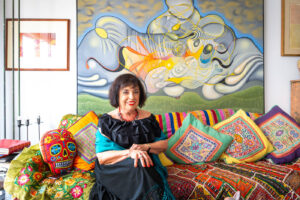 Jan, the catrina veracruzana, me and Manolo
Jan, the catrina veracruzana, me and Manolo
One of the things that I learned on this trip is that Veracruzans, as in other parts of Mexico, breakfast is still the most popular meal to eat out. At 8:00 AM El Gran Cafe de la Parroquia in the Port has a line to get in and the tables will be be sat over and and sat again with business men, journalists, tourists, government officials until about noon. Its namesake in Xalapa was also packed at that hour. Everywhere the menu options are staggering. I am testing recipes for a frittata made with plantains, scrambled eggs in a bean puree, eggs scrambled with shrimps, a fluffy omelet floating on an intense turkey broth to share with you.
We also had several invitations for breakfasts in people’s home. We accepted Manolo Izaguirre’s in Xico and had one of the absolute best meals of the whole trip.
We stopped at the famed Los Brujos to buy some bread and the bakery was abuzz. Jan could have stayed at the bakery all day rolling and shaping the silky, fluffy dough into turtles, flowers and decorated loaves of bread for the dead. I liked it too but was anxious to see Amado Manuel Izaguirre Virues, a part of the local landed gentry who can trace his heritage back to he 15th century. He is no longer the official city historian having lost his beloved post when the ruling party replaced him. His reaction was like that of a character in his book of marvelously evocative short stories, Cuentos de Albigarreto .He and everyone in town has ignored the new city historian and Manolo has continued gathering information undaunted for the official archive and had me research a statue of a “man with conical who is believed to be the founder of his little jewel of a town and that is on display at the Brooklyn Museum.
On his 50th birthday Amado decided he wants to be called Manolo, a common nickname for men named Manuel. His whole look changed with the name and , more probably, since the death of his honored mother, Doña Carmen. I worked with her closely while working on my book, Zarela’s Veracruz and gave me lots of recipes and a molcajete amanzado (a broken-in molcajete.) I don’t think she would have been happy that Manolo abandoned crisply ironed guayabera shirts for comfy striped polo shirts but his manner is more relaxed, almost devil-may-care now but he still has great presence and elegance even if he calls the help to the table by ringing a bell.
He had sent me the menu beforehand and my palate was primed for the dobladas de pepian, freshly made tortillas simply dipped into a rich and creamy pumpkin seed sauce and folded into quarters. This is the only dish on the whole trip that I asked for a second helping.The enmoladas xiqueñas with my all-time favorite mole de Xico were just as delicious as were the quesadillas stuffed with quintoniles and epazote, a type of green and served with the bracing salsa de chile seco, made from a paste of smoked morita chiles. But for Jan the black beans with xonequi, a leafy local green and masa dumplings were the top (recipe TK later.). That is until the tamales canarios made with rice flour instead of corn masa and stuffed with pastry cream were served as dessert.
Just as delicious was the sobremesa, the interlude after a meal, when everyone tells stories, jokes and you get the flavor of the people and the place. Raquel had shown up with her gorgeous protegee with the unusual name of Lesterloon Sanchez who has just graduated from culinary school .He wrote his dissertation in the form of a very good book in dummy form on cooking with flowers (more on him later.)
Xico is a picturesque town known for its food crafts so we set off on a tour after breakfast. That will be my next post.






